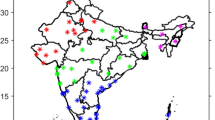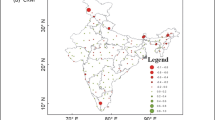Abstract
Dissimilarities in temperature trends in space and time over the Indian region have been examined to look for signatures of aerosols’ influence. Separate temperature time series for North and South India were constructed for dry (November–May) and wet (June–October) seasons. Temperature trend for the entire period 1901–2007 and different subperiods of 1901–1950, 1951–1990, 1971–2007, and 1991–2007 have been examined to isolate the aerosol and other greenhouse gas influences on temperatures. Maximum (daytime) temperatures during dry season corresponding to North and South India show significant warming trend of 0.8 and 1.0 °C per hundred years during the period 1901–2007, while minimum temperature shows nebulous trend of 0.2 and 0.3 °C per hundred years over North and South India, respectively. During the wet season, maximum temperature shows nearly half of dry season maximum temperature warming trend. However, asymmetry is observed in dry season maximum temperature trend during post-industrial period 1951–1990 wherein the North/South India shows decreasing/increasing trends, while during the recent period 1991–2007 trends are uniformly positive for both the regions. Spatial and temporal asymmetry in observed trends clearly point to the role of aerosols in lowering temperature trends over northern India. Atmospheric aerosols could cause a negative climate forcing that can modulate the regional surface temperature trends in a significant way. As this forcing acts differentially on day and night temperatures, trends in diurnal temperature range (DTR) provide a direct assessment of impacts of aerosols on temperature trends. Time series of diurnal temperature range for dry and wet seasons have been examined separately for North and South India. Over North India, the DTR for dry season has increased gradually during the period 1901–1970 and thereafter showed decreasing trend, while trends in temperature range over Southern India were almost opposite in phase with North India. The aerosol and greenhouse gases seem to play an important role in the spatial and temporal variability of temperature range over India.













Similar content being viewed by others
References
Dash SK, Hunt JCR (2007) Variability of climate change in India. Curr Sci 93(6):25
Hingane LS, Rupa Kumar K, Ramana Murthy Bh V (1985) Long term trends of surface air temperature in India. Int Jr Climatol 5:521–528
IPCC (2007) Climate change (2007): the scientific basis. Contribution of Working Group-I to the Fourth Assessment Report of Intergovernmental Panel on Climate Change (IPCC). Cambridge University Press, Cambridge
Jones PD, Moberg A (2003) Hemispheric and large-scale surface air temperature variations: an extensive revision and update to 2001. J Climate 16:206–223
Kothawale DR, Kulkarni JR (2011) Indian monsoon rainfall variability in warming scenario over Indian continent. Extended_ abstract_OCHAMP 2012
Kothawale DR, Munot AA (1998) Probabilities of excess and deficient southwest monsoon rainfall over different meteorological sub-divisions of India. Proc Ind Acad Sci (E & P Sci) 107:107–119
Kothawale DR, Rupa Kumar K (2005) On the recent changes in surface temperature trends over India. Geophys Res Lett 32:L18714. doi:10.1029/2005GL023528
Kothawale DR, Munot AA, Krishna Kumar K (2010) Surface air temperature variability over India during 1901–2007, and its association with ENSO. Clim Res 42:89–104. doi:10.3354/cr00857
Krishnan R, Ramanathan V (2002) Evidence of surface cooling from absorbing aerosols. Geophys Res Lett 29:54-1–54-4
Menon S, Hansen J, Nazarenko L, Luo Y (2002) Climate effect of black carbon aerosols in China and India. Science 297:2250–2253
Middleton NJ (1986) A geography of dust storms in southwest Asia. Int J Climatol 6:183–196
Ming J, Cachier H, Xiao C, Qin D, Kang S, Hou S, Xu J (2008) Black carbon record based on a shallow Himalayan ice core and its climate implications. Atmos Chem Phys 8:1343–1352
Padma kumari B, Londhe AL, Daniel S, Jadhav DB (2007) Observational evidence of solar dimming: offsetting surface warming over India. Geophys Res Lett 34:L21810. doi:10.1029/2007GL031133
Panikar AS, Pandithurai G, Safai PD, Kewat S (2008) Observation of enhanced aerosol long wave radiative forcing over an urban environment. Geophys Res Lett 35:L04817. doi:10.1029/2007GL032879
Porch W, Chylek P, Dubey M, Massie M (2007) trends in aerosol optical depth for cities in India. Atmos Environ 4:7524–7532
Prasad AK, Singh RP, Singh A ( 2004) Variability of aerosol optical depth over Indian subcontinent using MODIS data. Jr Indian Society Remote Sens 32(4):313–316
Prospero JM, Ginoux P, Torres O, Nicholson SE, Gill TE (2002) Environmental characterization of global sources of atmospheric soil dust identified with the Nimbus 7 Total Ozone Mapping Spectrometer (TOMS) absorbing aerosol product. Rev Geophys 40(1):1002. doi:10.1029/2000RG000095
Ramanathan V, Ramana MV (2005) Persistent, widespread, and strongly absorbing haze over the Himalayan foothills and the Indo-Ganges basins. Pure Appl Geophys 162:1609–1626
Ramanathan V, Ramana MV, Robert G, Kim D, Cooigan C, Chung C, Winker D (2007) Warming trends in Asia amplified by brown cloud solar absorption. Nature 448(2):575–578. doi:nature 06019/nature06019
Rao YP (1976) Southwest monsoon. India Meteorological Department, New Delhi, pp 1–366
Rao PGS, Jaswal AK, Kumar MS (2004) Effects of urbanization on meteorological parameters. Mausam 55(3):429–440
Reddy MS, Venkataraman C (2002a) Inventory of aerosol and sulfur dioxide emissions from India: I. Fossil fuel combustion. Atmos Environ 36:699–712
Reddy MS, Venkataraman C (2002b) Inventory of aerosol and sulfur dioxide emissions from India: II. Biomass combustion, fossil fuel combustion. Atmos Environ 36:677–697
Roy SS (2008) Impact of aerosol optical depth on seasonal temperatures in India: a spatio-temporal analysis. Int J Remote Sens 29(3):727–740
Rupa Kumar, Krishna Kumar K, Pant GB (1994) Diurnal asymmetry of surface temperature trends over India. Geophys Res Lett 21:677–680
Sarkar SR, Chokngamwong G, Cervone RP, Singh KM (2006) Variability of aerosol optical depth and aerosol forcing over India. Adv Space Res 37(12):2153–2159
Srivastava HN, Dewan BN, Dikshit SK, Prakash Rao GS, Singh SS, Rao KR (1992) Decadal trends in climate over India. Mausam 43:7–20
Tripathi SN, Tare V, Chinnam N, Srivastava AK, Dey S, Agarwal A, Kishore S, Lal RB, Manar M, Kanwade VP, Chauhan SS, Sharma M, Redd RR, Rama GK, Narasimhulu K, Siva Sankara Reddy L, Gupta S, Lal S (2006) Measurements of atmospheric parameters during Indian Space Research Organization Geosphere Biosphere Programme Land Campaign II at a typical location in the Ganga basin: 1, Physical and optical properties. J Geophys Res 111:D23209. doi:10.1029/2006JD007278
Wigley TML, Jones PD (1981) Detecting CO2 induced climatic change. Nature 292:205–208
Yu H, Liu SC, Dickinson RE (2002) Radiative effects of aerosols on the evolution of the atmospheric boundary layer. J Geophys Res 107(D12):4142
Zhang J, Reid JS (2010) A decadal regional and global trend analysis of the aerosol optical depth using a data assimilation grade over-water MODIS and Level 2 MISR aerosol product. Atmos Chem Phys 10:10949–10963
Acknowledgments
The authors are thankful to Director Prof. B. N. Goswami, Indian Institute of Tropical Meteorology (IITM) Pune for providing the necessary facilities for this study. The authors are also grateful to National Data Center of India Meteorological Department for providing the surface and upper air temperature data.
Author information
Authors and Affiliations
Corresponding author
Rights and permissions
About this article
Cite this article
Kothawale, D.R., Kumar, K.K. & Srinivasan, G. Spatial asymmetry of temperature trends over India and possible role of aerosols. Theor Appl Climatol 110, 263–280 (2012). https://doi.org/10.1007/s00704-012-0628-8
Received:
Accepted:
Published:
Issue Date:
DOI: https://doi.org/10.1007/s00704-012-0628-8




